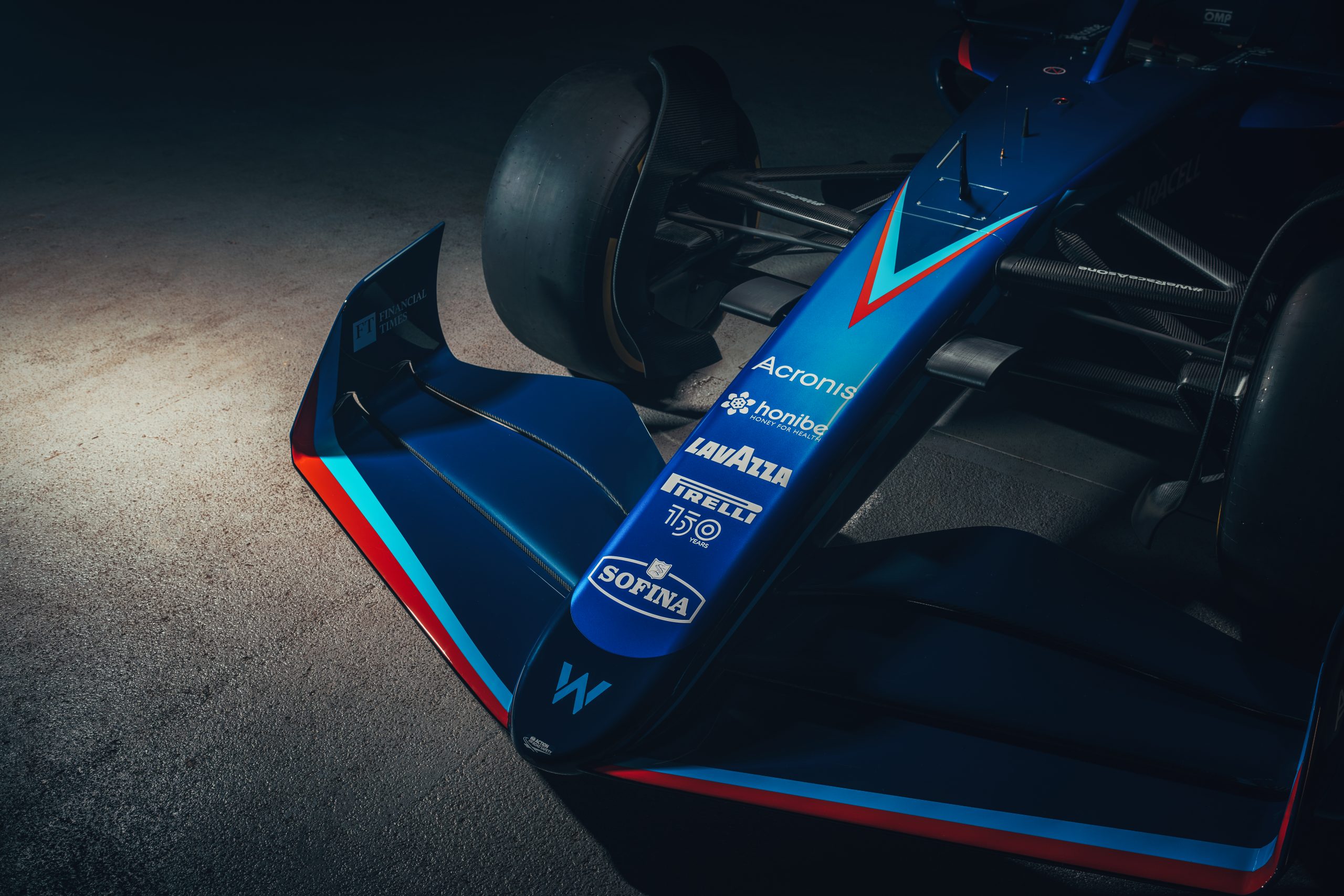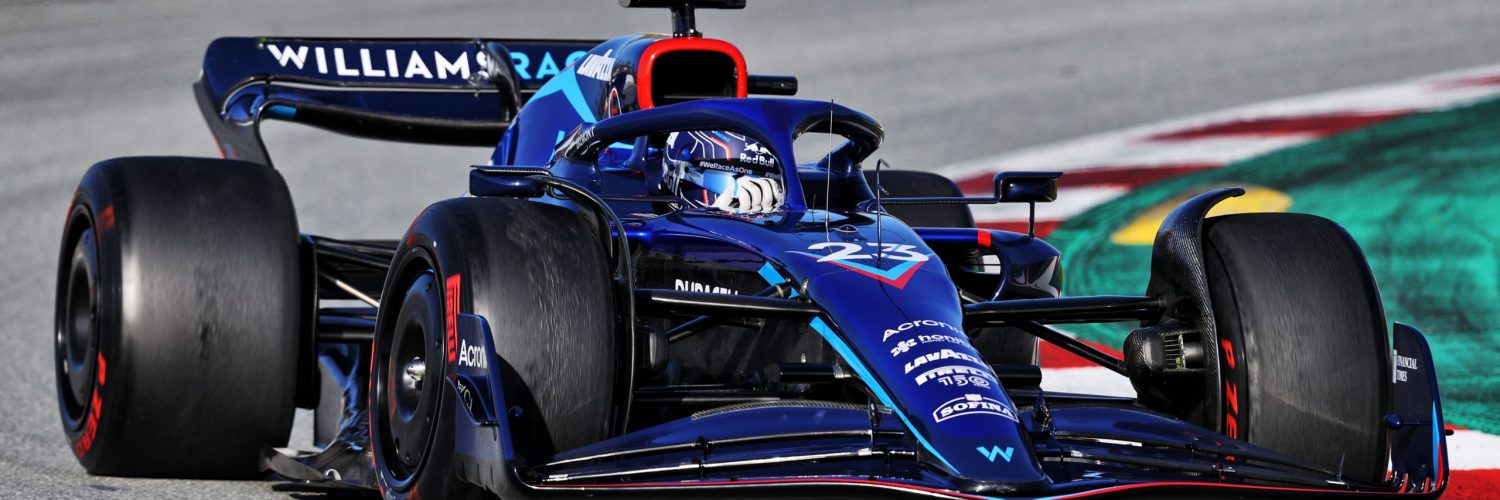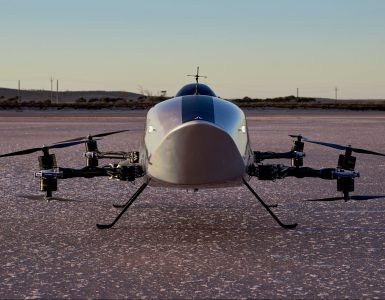For Williams in 2022 it’s a new era in two ways. Firstly the F1 regulations have demanded an almost completely changed car, and the new management structure is in place to tackle the coming years. The fruit of these new dawns is the FW44, the all new F1 car from the Oxford based team.
But rather than a conservative design aimed to ease the team into this new era, the new car is radical and unlike anything else we have seen before. With its extreme sidepods and blue diamond livery, this is an aggressive step towards the future for the team.
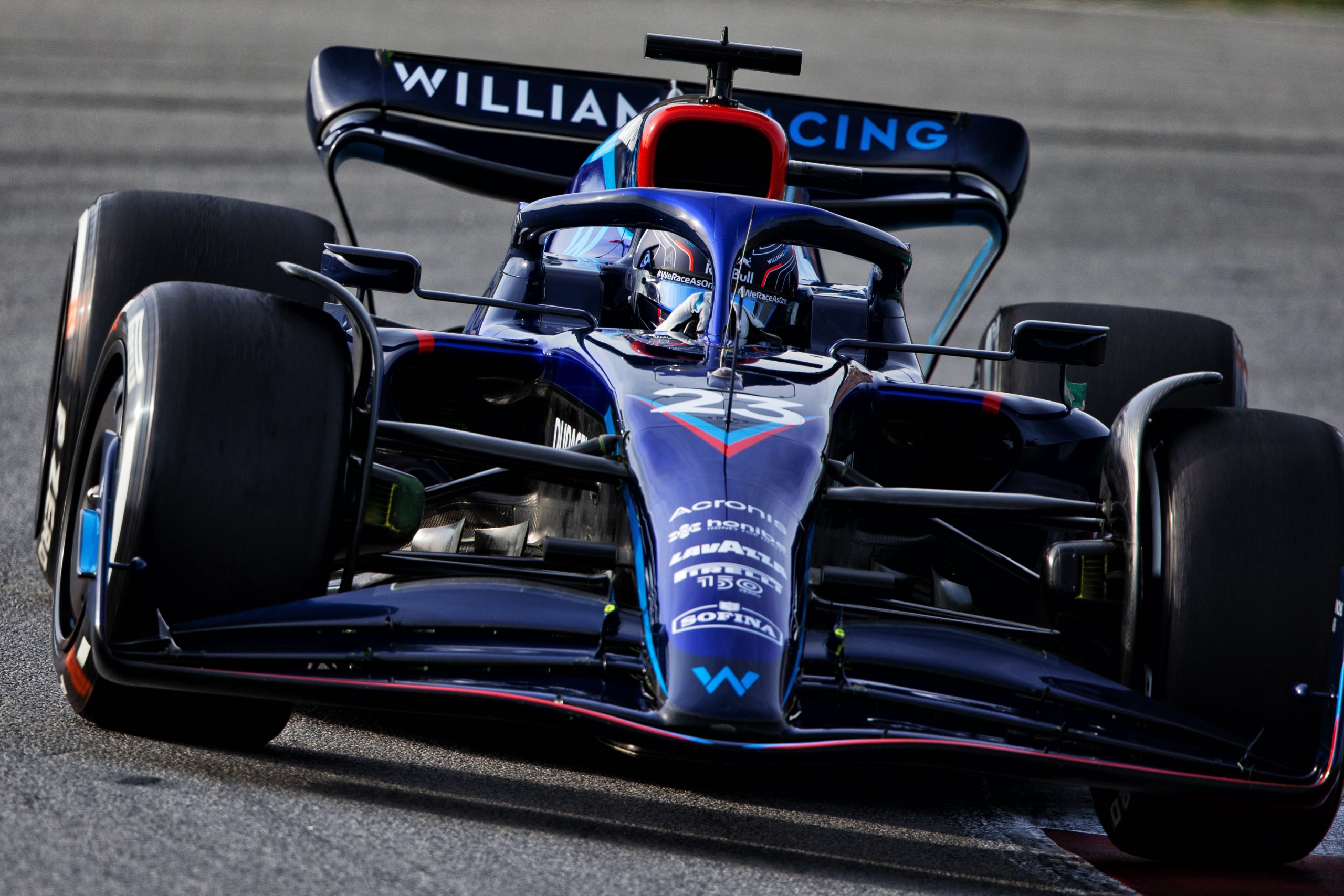
For 2022, there are all new technical regulations to control the design of the cars, aimed at allowing car to be able to follow each other more closely and to bring the field together with budget and resource controls. Literally every aspect of the design of the new car must be new, in terms of carry over most teams simply have the steering wheel as a common part!
For Williams, 2022 means an all new car, but the existing relationship with power Unit supplier Mercedes has been extended to include the gearbox for the first time.
Looking at the FW44 from front to rear, its clear the team have left nothing back in terms of tackling the challenging new regulations. In doing so Williams have made a car as different from its rivals, as it’s possible to make.
FRONT END
Looking at the front, the nose wing assembly is typical of the new approach by the team. The wing itself is what’s called mid loaded because with the new rules, teams want to create the front end downforce in the middle of each side of the front wing. This is done to keep a clean airflow to the ground effect tunnels under the car and to keep the wings interaction with the endplate to a minimum.
Aiding the clean air policy to feed the underfloor, the nose stops short of the front wing, such that the front wing main plane hangs below the nose, helping direct airflow neatly towards the tunnels. The nose itself also aids this airflow by being rounded in cross section. This streamlines the nose to allow air to flow around the nose to pass cleanly under the car.
Part of the new rules is additional bodywork around the wheels. This takes the form of the wheel cover and the inner brake ducts/deflectors. There are virtually spec parts and teams can tune the inner brake duct/deflector in limited ways, although overt reshaping for aero gain is barred.
While this may lead to criticism of the new rules, having such covers and deflectors really help to control the airflow along the car without upsetting the airflow to the car behind. It’s a case of some toys being taken away from the team, but for good reason.
What’s left for Williams to adapt are the brake cooling scoops. These now need to feed both into and out of the hot brakes. None of the hot air from the brakes passes out through the wheel, rather out of the far end of the brake duct scoop. Williams scoops are particularly complex, with quite a large shape and three inlets. Some of this will be to cool the brakes, while some may be for aerodynamic effect, as a means to claw back some airflow control held back by the regulations.
Front suspension layout is revised for both the new 18” wheels and the revised suspension regulations. The outer suspension passes into the front wheel (by regulation) and the inner springs and dampers are operated by a push rod, in contrast to the pull rod option adopted by a few of the other teams. What goes on within the springs and dampers is shrouded in secrecy. All of the complex suspension tricks from last year were banned in the rules, with just springs and dampers operated by the rockers. Every team will have to be clever with their engineering to get good wheel control back.
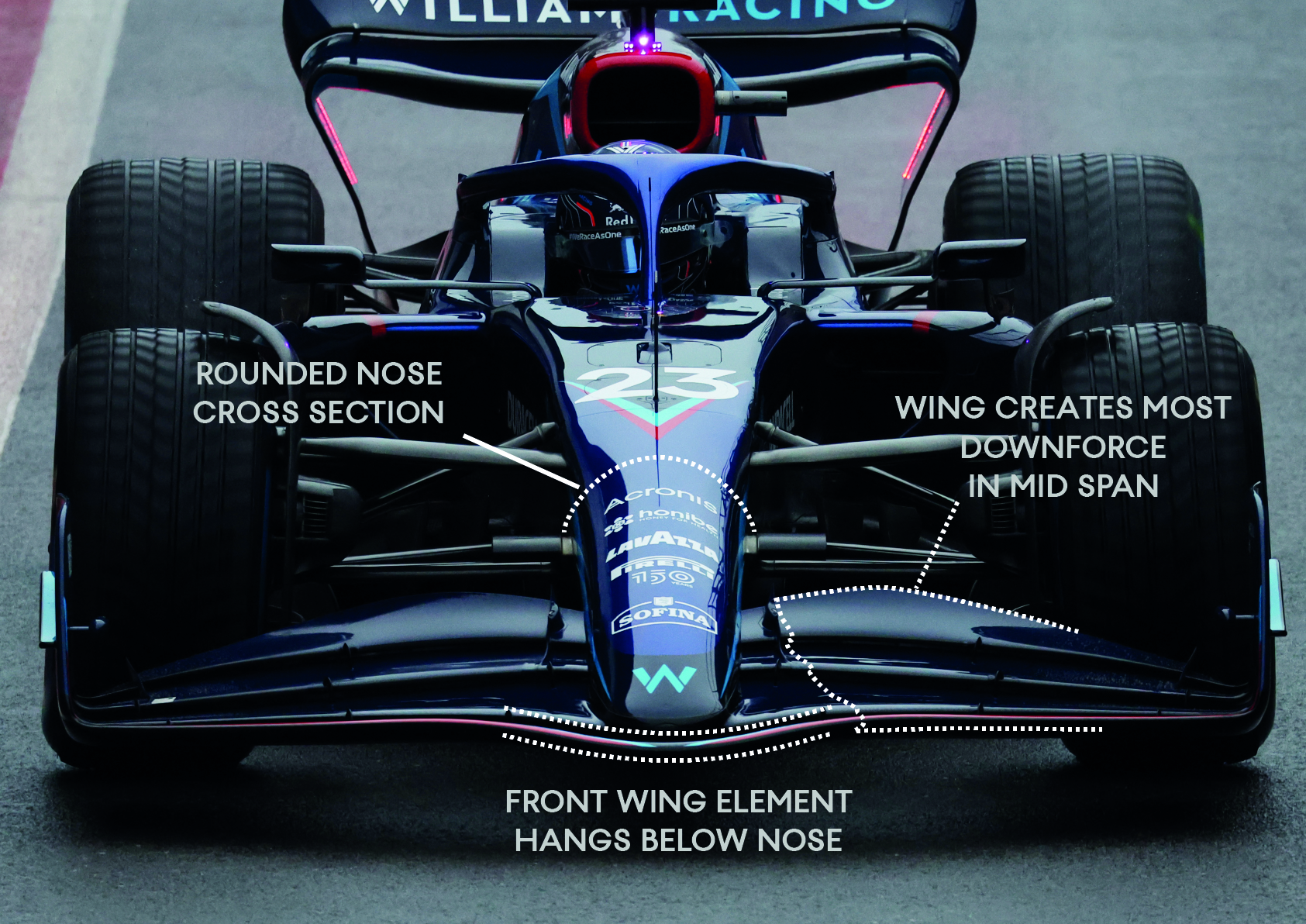
SIDEPODS
While there was criticism aimed at F1 in the second half of 2021 in that the new cars will be too similar and create spec series, this has proven to be wide of the mark. In fact, the technical variety in the car’s designs see every team with a near unique solutions to meet the new rules. Given the limited view we’ve had under the skin of these car, the most visible differentiator has been the sidepod and cooling package. The new rules set out a larger space for sidepods, albeit with limited shape and the banning of bargeboards. So, it’s ironic that Williams chose to go with almost no sidepods at all!
What we can see from the outside are very small forward placed sidepods, with a large inlet, deep undercut and a top surface that dramatically slope downwards back into the floor. Given the sidepods have to cool the +1000hp engine and hybrid systems, the turbocharger, the gearbox and hydraulics, there’s the question how do Williams cools everything with such small ‘pods’? Well, the answer lies away from the sidepods and over the top of the gearbox, where Williams have placed two large radiator arrays fed by the roll hoop inlet. This make the upper bodywork effectively the sidepod.
What’s then within the tiny sidepods is quite unique. There is a small radiator inside, but this only fills the bottom half of the bodywork leaving the function of the top half of the sidepod something of an enigma.
Looking through the sidepod inlet it’s immediately apparent there’s a horizontal split, the split being provided by the side impact protection structure (SIPS). The upper sidepod half may be used to duct air into the engine bay, but at some angles clear air is visible through the upper duct. The light is coming from an opening on the rear of the sidepod.

A detachable panel allows a different opening to be used, but apparently not for cooling, so the through-duct is therefore aerodynamic. Perhaps it’s to aid the airflow flow back down the heavily sloped sidepod, keeping airflow attached and allowing the extreme shape. Through testing Williams went from no opening to larger outlets, so it will be interesting to see how and when the team choose to exploit this ductwork trick.
Such short sidepods expose the flanks of the monocoque and engine, creating a sloped midriff to the car. This area is also employed to help with the cooling of the car, there being a large removable panel to allow louvers to let heat away from the cooler and engine. As with the sidepod through-duct, this will be tuned to suit the track, more louvers on hot track and less louvers to cut drag on fast tracks.
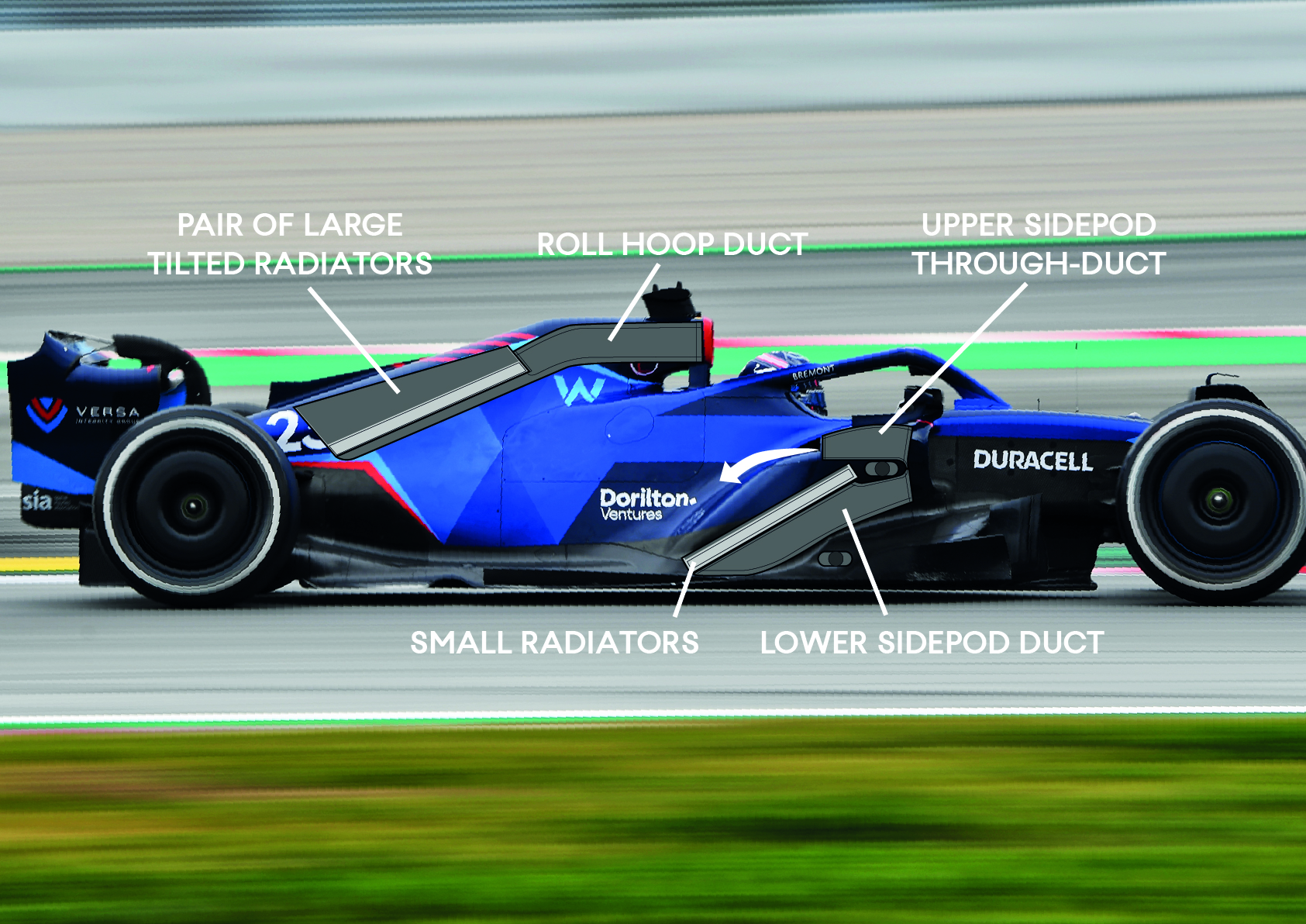
DRIVER INTERFACE
As mentioned at the top of the article, very little is carried over to the new car, but Williams have chosen to carry over their equally unique butterfly steering wheel. Having run this design since 2014, the wheel is a small device carrying only the buttons and paddles, leaving the colour dash display to be mounted on the cockpit front. For such a small design detail, this has created more interest and debate than nearly anything else over the intervening years.
The initial design decision to mount the dash separately was probably a simple decision, originally chosen to reduce the inertia to the steering column. But this leaves the dash hidden by the wheel in corners, confusing many a fan. But drivers don’t actually look at the wheel in corners, their attention is further up the track looking at the next corner. Therefore, reading the dash is mainly left for the straights.
Drivers also have the rear view mirrors. Basically a simple plastic ‘mirror’ in a housing, the purpose for the design team is to exploit the mirror housing and mounting for aerodynamic effect, using what the rules allow for mountings as fins or vanes. Williams is no different, there being a horizontal mount, directing airflow down the back of the sloped sidepods. Then there’s a vertical mount with extends backwards to create vane curving around the shoulder of the sidepod, directing airflow in a similar place to the through-duct in the upper sidepod.
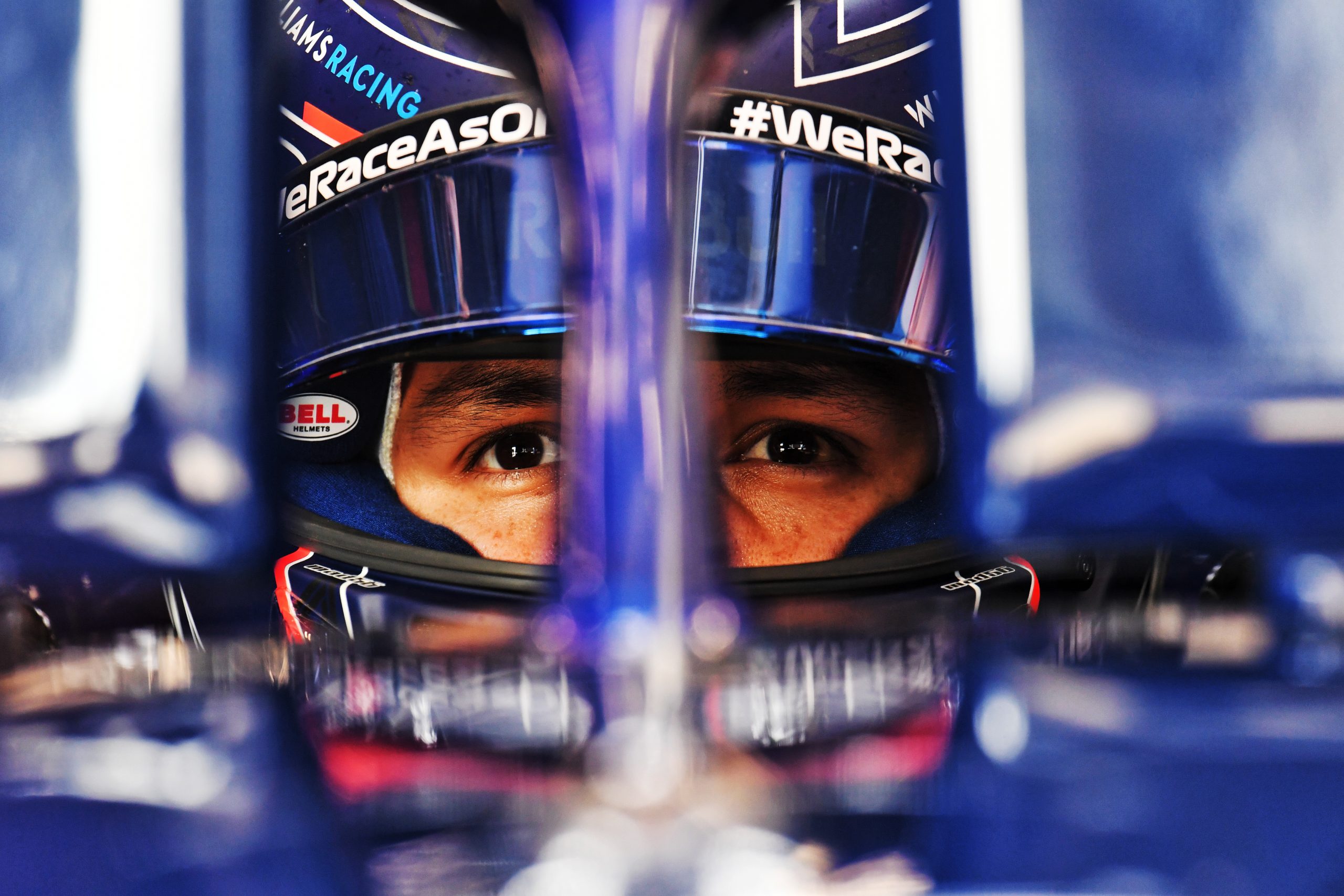
UNDERFLOOR
For all of the aero detail around the rest of the car, it’s the shaped underfloor tunnels that are critical to the new car’s performance. Again, Williams have been clever and found some tricks within the rules. The underfloor is made up of the converging throat section at the front, then in the middle the lowest flattest section before a pair of long diffuser tunnels rise up at the back of the car.
In the throat section, teams are allowed vertical fences to shape airflow under the floor. Williams read the rules carefully and saw that not only could they have these fences under the floor, but they could also be higher and direct airflow over the floor too! While it might be thought these fences direct airflow along the floor, they actually are used largely to direct airflow laterally to pass out under the floor edge.
This might seem like airflow is being robbed from the main tunnels, which are only fed from the small opening between the two inner fences. But this lateral airflow creates lots of downforce at the front of the floor and this helps balance the car’s downforce front to rear.
To maximise this laterally expanding airflow, Williams have added a winglet over the floor edge. The scrolled design encourages the air to accelerate under the floor edge and directs it along the floor edge in between the diffuser and rear tyre.
The key word in testing with these new ground effect cars was ‘porpoising’. This is where the car bounces up and down along the straight as the downforce builds up. It squashes the car to the track and for some treason the aerodynamics stall and the car bounces back up as its relieved of its downforce. This sets off a cycle of squash, stall and bounce, which looks as alarming to fans as I’m sure it is for the driver! Interestingly, Williams suffered a lower level of this phenomenon in contrast to many of the other teams.
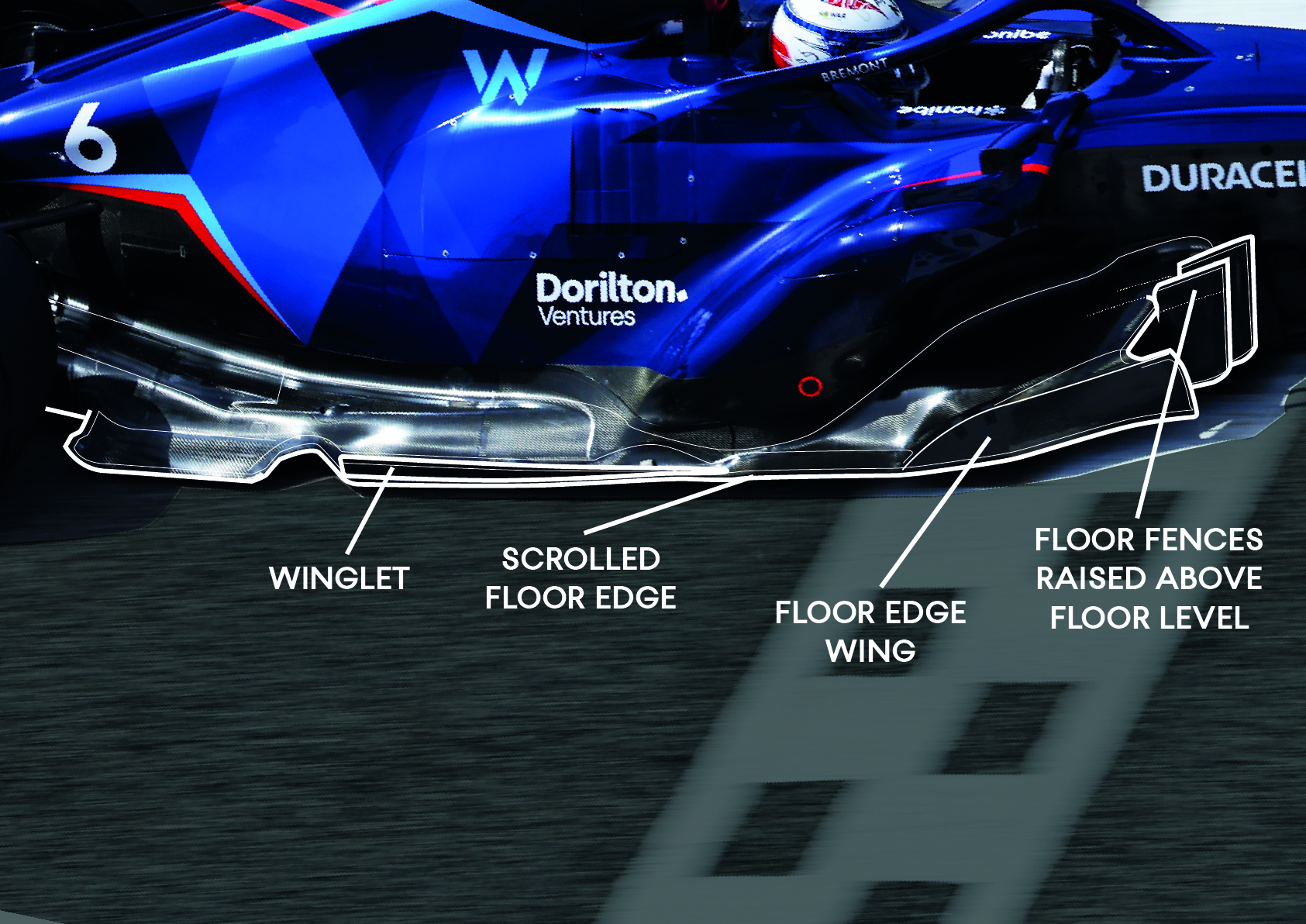
POWERTRAIN
Able to extract over 50% of the energy from its fuel, the Mercedes Power Unit puts out +1000hp and proved reliable through testing. The power units were allowed to be upgraded over the winter, then the design has been homologated until 2026. The leader in F1 PU’s since 2014, the Mercedes unit has been upgraded to boost performance and also slimmed to allow for better aero packaging. This certainly has allowed Williams to exploit its rear mounted cooling package.
There remains one question with the PU and cooling set up – how the turbocharger cools its charge air. Williams have run an air-to-air intercooler in the sidepod since 2014. This is a light and efficient cooler, but it is bulky and added to the space needed for the car’s cooling package. It’s now known Mercedes HPP have a new intercooler that exploits 3D manufacturing and ricket technology.
Mercedes AMG F1 have run an air-to-water intercooler since 2014 that uses a liquid jacket around the charge air pipework for cooling. It means the intercooler doesn’t have to sit in the airflow but does require a small water radiator in the sidepod. This set up is therefore better aerodynamically, but also heavier and more complex. As yet, no bulky intercooler has been evident on the FW44, so may be Williams have the clever tech in their car too.
Behind the V6 engine Williams has broken the tradition of creating their own gearbox by taking the Mercedes gear cassette. This mounts inside a carbon outer case, known as the carrier. Having the cassette that contains the entire gear cluster and differential assembly means Williams can gain an efficient gearbox at reasonable cost, but still have control over the rear structure of the car and the all-important rear suspension geometry.
Therefore, at the rear of the car Williams have retained a pull rod rear spring/damper operation. The smaller details are very neat, such as the single supporting pylon for the rear wing and DRS mechanism.

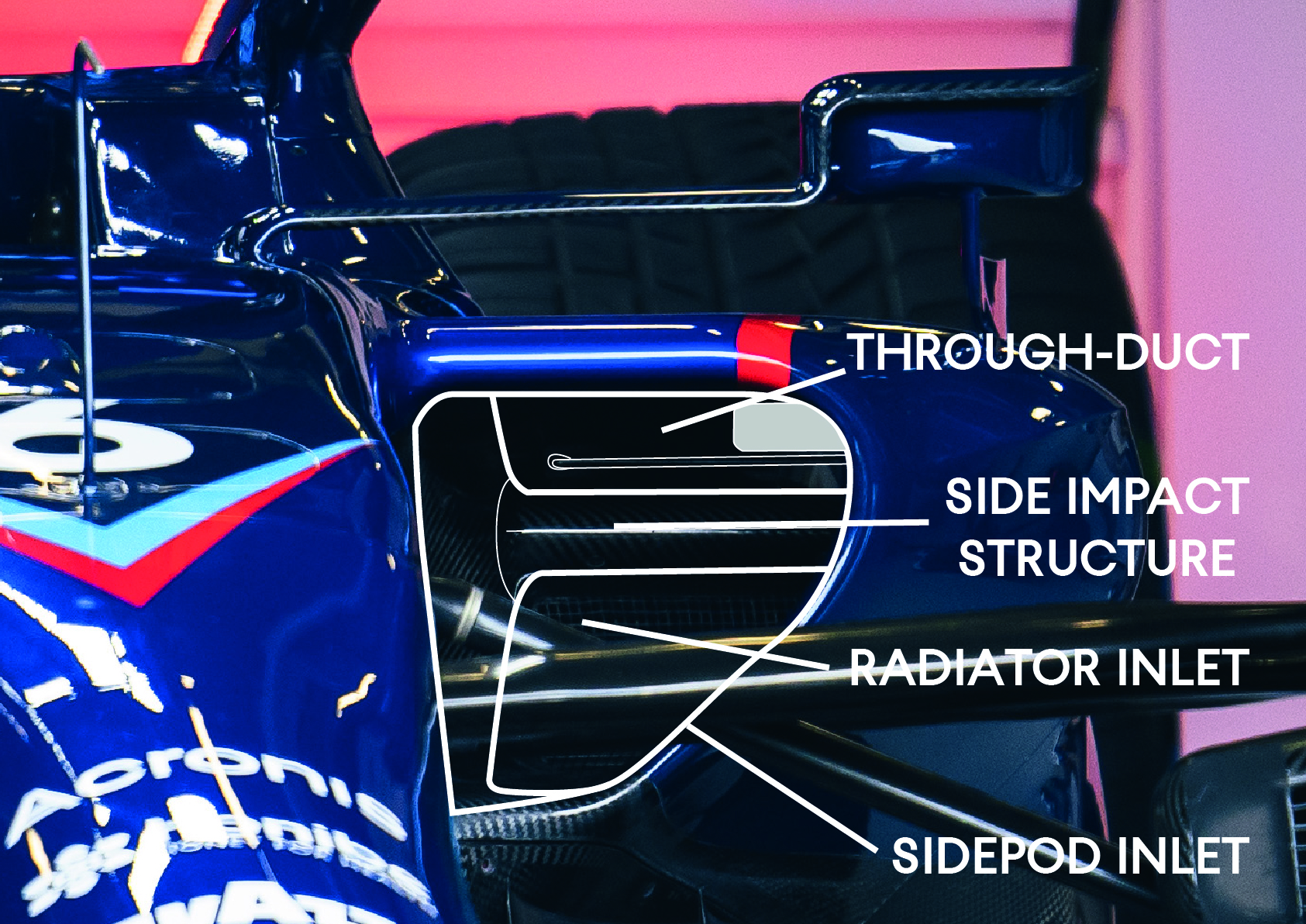
CHALLENGE AHEAD
Testing ended up being a challenging affair, with a brake fire halting the first day of running and reducing track time in what was only a 3-day test in Bahrain. But Williams aggressive and forward-thinking approach to the rules shows it pushing hard to get back on terms in F1. Testing proved the car was stable and without much porpoising problems yet more time is likely needed to get the best out of the package.
In a season where the fight in the midfield will be cut throt, Williams are ready with the FW44.
TEAM UP WITH ACRONIS
Prominent once again on the nose of the car and on the front wing endplates are the team’s official cyber protection partner Acronis. Williams Racing uses Acronis technology to add extra layers of protection to its IT infrastructure, protecting hundreds of servers and endpoint devices.
During the 2021 season, Acronis opened up an exciting #TeamUp Program, giving new and existing service providers the opportunity to support sports partnerships, join the sports ecosystem, attend races and enjoy amazing sports marketing benefits. To find out more, please visit https://www.acronis.com/en-us/lp/msp-sports/
